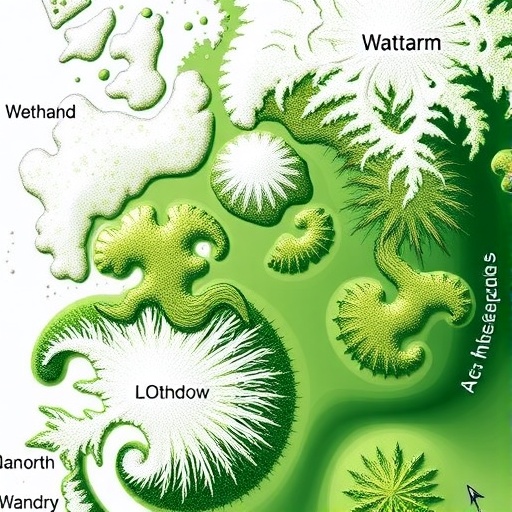Recent research has illuminated a significant flaw in our understanding of methane emissions from Arctic-Boreal wetlands, a critical component in the global carbon cycle. In a groundbreaking study conducted by Hashemi, Räsänen, and Virtanen, the authors revealed that existing coarse land cover datasets provide a skewed representation of wetland methane budgets. This research, published in Commun Earth Environ, promises to reshape how scientists and policymakers view greenhouse gas emissions from these sensitive ecosystems.
Methane, a potent greenhouse gas, is released from wetlands, especially in Arctic and Boreal regions, where climatic changes are accelerating. These ecosystems are essential for carbon storage; however, when data is based on coarse land cover maps, it drastically underrepresents the actual methane emissions. The findings of this research underscore the necessity for high-resolution datasets that can accurately capture the diverse landscapes of Arctic-Boreal wetlands and provide a clearer picture of their environmental impact.
The study highlights the inadequacies of current land cover datasets which often do not reflect the complexity of these regions. By relying on simplified representations, researchers may be fundamentally miscalculating methane emissions. The authors argue that high-resolution mapping can uncover significant variations in methane release depending on local wetland types, hydrology, and vegetation cover. These factors are often overlooked in broader assessments, leading to biased estimations of climate contributions by wetland environments.
It is crucial to understand that not all wetlands are created equal. The nuances in topography, hydrology, and vegetation can lead to differing methane production rates. The research team employed innovative approaches to create refined datasets that account for this complexity. By integrating local ecological data with satellite imagery, they generated a more precise representation of wetland types across several Arctic-Boreal landscapes. The result is a detailed mapping system that highlights the areas most significant for methane emissions.
In addition, the study delves deep into the implications of these findings for climate policy. As global leaders strive to meet emissions targets, understanding the true contributions of wetlands becomes crucial. The authors argue that miscalculating methane emissions from these ecosystems could mislead policymakers, potentially resulting in inadequate climate action plans. Accurate data is essential to developing effective strategies that mitigate global warming and protect sensitive ecosystems.
The researchers also call attention to the need for continued long-term monitoring of Arctic-Boreal wetlands. As temperatures rise, these areas are expected to undergo significant changes, which could further affect their capacity to sequester carbon or emit methane. A combination of advanced remote sensing technologies and field studies will be vital in tracking these changes, ensuring that emissions models remain robust and reflective of real-world conditions.
This study sets a precedent for future research by advocating for the incorporation of detailed ecological parameters into climate models. It challenges scientists to rethink traditional methods of data collection and encourages interdisciplinary collaborations. By bridging satellite technology with ground-based observations, researchers can build a more comprehensive understanding of the factors influencing methane emissions.
Additionally, the findings prompt a call to action for stakeholders, including conservation organizations and government agencies. Without a nuanced understanding of wetland dynamics, efforts to restore and protect these areas may be misinformed. The research advocates for policymaking grounded in accurate science, emphasizing that restoration efforts should be directed toward the most impactful wetland types identified through high-resolution datasets.
Moreover, as urbanization and industrial activities encroach upon natural landscapes, understanding the changing dynamics of wetlands becomes increasingly imperative. The study warns that human-induced alterations can exacerbate methane emissions, further complicating the challenge of climate change. Stakeholders are urged to incorporate findings from this study into land management strategies and economic assessments regarding land use.
The importance of community-engaged science is underscored throughout the paper. The authors highlight successful collaborations with local communities in gathering data, emphasizing that traditional ecological knowledge can enhance scientific understanding. By integrating local insights with scientific research, a more holistic approach to ecosystem management can be realized.
The research opens up numerous avenues for further investigation into climate dynamics, particularly concerning the feedback loops between climate change and wetland function. As the Arctic continues to warm, it remains vital to understand how these gases interact with atmospheric processes and how alterations in land cover may alter methane’s role in the global carbon cycle.
Ultimately, the work of Hashemi et al. serves as a critical reminder that the mechanisms governing our planet’s climate are complex and interconnected. It insists that an investment in technological advancements and local ecological insights will significantly enhance our preparedness to face future climatic challenges. The shift towards high-resolution mapping can lead to more effective strategies, targeted legislation, and a framework for understanding an ecosystem that plays a pivotal role in regulating the planet’s climate.
The implications of this research extend beyond the Arctic-Boreal regions. Methane emissions from wetlands are a global concern, and understanding these emissions at local scales provides insights applicable worldwide. As the scientific community continues to explore and document the impacts of climate change, studies like this one pave the way for informed discussions and decisions that affect our environment today and in the future.
In conclusion, the quest for accurate methane budget assessments emphasizes a larger story about the balance of ecosystems and climate. The Arctic-Boreal wetlands represent a crucial link in our planet’s climate narrative, and only by sharpening our focus on their complexities can we hope to stabilize our climate future.
Subject of Research: Arctic-Boreal wetlands methane emissions and their modeling biases.
Article Title: Coarse land cover datasets bias Arctic-Boreal wetland methane budgets.
Article References:
Hashemi, J., Räsänen, A., Virtanen, T. et al. Coarse land cover datasets bias Arctic-Boreal wetland methane budgets.
Commun Earth Environ 6, 903 (2025). https://doi.org/10.1038/s43247-025-02963-1
Image Credits: AI Generated
DOI: https://doi.org/10.1038/s43247-025-02963-1
Keywords: methane emissions, Arctic-Boreal wetlands, greenhouse gas, land cover datasets, climate change, ecosystem dynamics.




